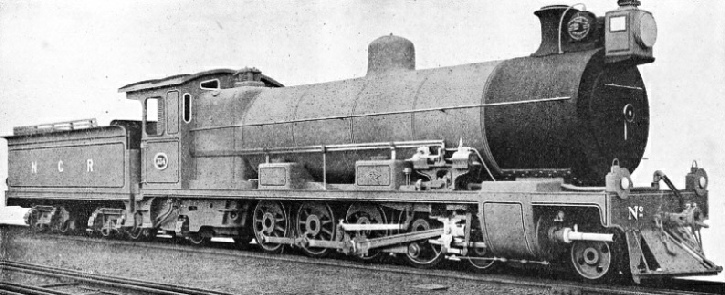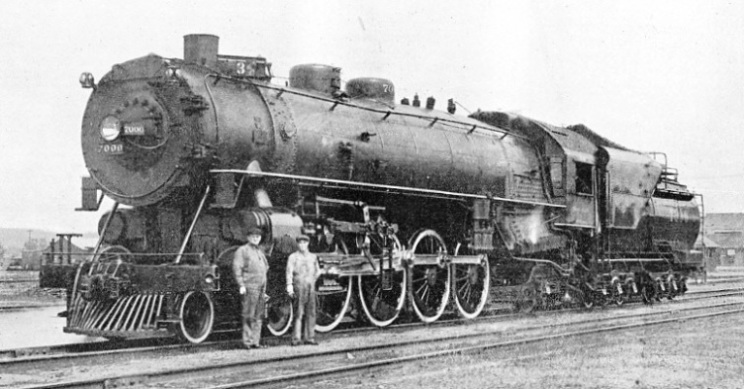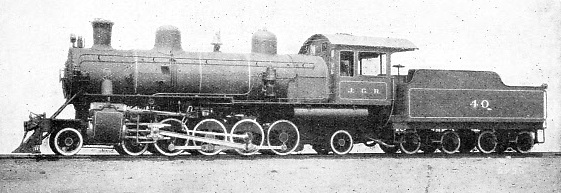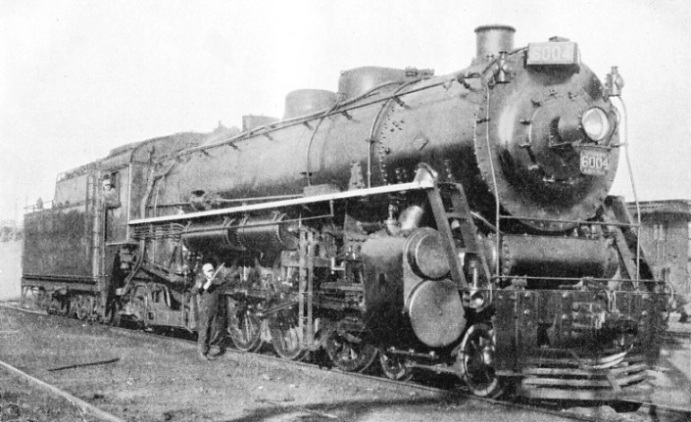The Newest and Most Powerful Locomotive for Passenger Service on Heavy Gradients
LOCOMOTIVES - 43

THE FIRST “MOUNTAIN” BUILT FOR THE NATAL DIVISION OF THE SOUTH AFRICAN GOVERNMENT RAILWAYS. This type, which grew out of the “Mastodon”, was evolved in 1908. The first five locomotives of this design were built by the North British Locomotive Company, and went into service in 1909. They have cylinders 21 by 24 inches, and a steam pressure of 200 lb per square inch. The eight coupled driving wheels are 45½ in diameter.
THE youngest member of the large locomotive family, the talk of the railway world to-day, came, as in the case of the “Pacific”, from one of the British Dominions - South Africa. Natal presents the traffic manager with as perplexing a prospect as could be desired, because the railways thread the mountains with heavy banks and curvature, and are called upon to handle considerable traffic. In 1908 Mr. D. A. Hendrie, the locomotive engineer, was confronted with the demand for a more powerful locomotive to work the heavy freight services through the most arduous reaches of Natal. To cope with the situation he took the well-tried and reliable “Mastodon”, and improved its steaming qualities by providing it with a deep fire-box carried down between the frames - widened out at that end for the purpose - and introduced a trailing axle for support, thus giving the wheel arrangement of 4-8-2.
The first five locomotives of this design were built by the North British Locomotive Company. They have cylinders 21 by 24 inches stroke, working at a pressure of 200 lb, and connected to the eight coupled driving wheels 45½ inches in diameter. The total heating surface is 2,718 square feet, the tubes representing 2,582 and the firebox 136 square feet, respectively; the grate area is 34 square feet. The maximum axle load is 33,824 lb. At 75 per cent, of the boiler pressure the tractive effort is 35,280 lb.
This new type went into traffic in 1909, and gave such satisfactory results that a further 25 locomotives were acquired; the whole of these were built in the Glasgow shops of the builders mentioned, in 1911. Shortly afterwards the same builders supplied a further ten engines of similar type, which in all essential features are identical, but fitted with the superheater. The successful working of these locomotives in the difficult country of Natal prompted Mr. H. M. Beatty, C.M.G., then chief locomotive engineer to the Cape Government Railways, to adopt the same type for heavy passenger duty upon his system. These locomotives have cylinders 20½ by 28 inches, and driving wheels 54 inches in diameter. The total heating surface provided amounts to 2,317 square feet - 2,131 square feet for the tubes and 186 square feet for the fire-box - and a grate area of 37 square feet.
Two of these locomotives were acquired to work the trains through the coastal section of the Cape Province, which, like Natal, is mountainous, though the grades and curvature are less exacting. At the time they, with those designed by Mr. Hendrie, constituted the heaviest rigid engines in South Africa. Having been built solely for working the trains through the heavy country, they became known as the “Mountain” type - though the distinctive appellation was not applied until later - and proved so eminently satisfactory as to lead to their general employment throughout the railways of the Union of South Africa.
Some two or three years after Mr. Hendrie had conclusively demonstrated the possibilities of this type of locomotive it invaded the United States, the trail being blazed by the Chesapeake and Ohio Railroad, which was experiencing difficulty in the economical working of its express trains through the Alleghany Mountains. While this barrier is not so formidable as the Rockies or Cascades, it is wild and ragged, the lofty tree-clothed humps pressing together, and riven by deep yawning canons; the sides of these are so steep that the constructional engineers were forced to water-level, where the line is carried upon a narrow shelf, formed by trimming back the toes of the flanks, a few feet above the river.

THE FIRST AMERICAN “MOUNTAIN” TYPE (4-8-2) HIGH SPEED LOCOMOTIVE. Built for the Chesapeake and Ohio Railroad by the American Locomotive Company, this locomotive, ready for the road, scales 493,400 lb. Its cylinders are 29 by 28 inches, and steam pressure 180 lb. to the square inch. The driving wheels are 62 inches in diameter.
The heaviest part of the main line is between Covington, 223 miles from Washington, on the eastern slope of the mount-ains, and White Sulphur Springs on the western flank, a distance of 20 miles, though the difficult going continues for a further 100 miles to Gauley. Covington is at an elevation of 1,245 feet above sea-level, and a further 1,245 feet have to be overcome in the course of the 16 miles to Alleghany, the summit-level, where the ridge is pierced by a tunnel; to gain the summit involved the construction of an embankment 220 feet in height (the highest in the world), known as Jerry’s Fill. After negotiating the summit, there is a steady descent through 500 feet for the succeeding 6 miles to White Sulphur Springs. These 20 miles over the summit-ridge were the most expensive constructionally on the whole system, the average cost exceeding £60,000 per mile.
Following the Greenbrier River, Ronceverte, 11 miles beyond, is reached at 1,700 feet, and this station is at the foot of the east-bound climb over the mountains, although, owing to the wonderful location discovered by the pathfinders, the ascent through the 14 miles is only 30 feet per mile. Still falling gradually, the railway clings to the Greenbrier River until its con-fluence with the New River, which is now picked up and followed for 59 miles through the canon winding between the humps, and what is probably the wildest gorge of the Alleghanies threaded by the railway. For mile after mile the river is hemmed between two tracks - that on the north side is the main, while the road on the southern bank, although a dup-licate, has been laid essentially to develop the rich coal traffic in this ravine; about 20,000 tons are collected daily and loaded into trains.
The passenger trains comprise ten all-steel cars, and to maintain speed through the mountains the company frequently had to resort to double-heading with powerful “Pacifics”. In order to avoid this wasteful employment of motive power, the American Locomotive Company were requested to design a unit of sufficient capacity to haul the train unaided over the heaviest sections of the road at the same or increased speed.
The “Mountain”, 4-8-2 type, was the response. It has cylinders 29 inches in diameter by 28-inches stroke, and 62-inch driving wheels. The boiler, 83¾ inches in diameter, has 283 tubes, 19 feet in length, giving a total heating surface of 3,795 square feet; the steam working pressure is 180 lb per square inch. The fire-box is 114⅛ inches long by 84¼ inches wide, with 310 square feet of heating surface. The total heating surface, including water-tubes is 4,132 square feet; of super-heater 845 square feet; grate area 667 square feet. The driving wheel-base is 16 feet 6 inches; of engine, 37 feet 5 inches; and locomotive complete with tender, 70 feet 6 inches. The last-named, of the 8-wheeled type, with capacity for 9,000 gallons of water and 30.000 lb of coal, weighs 163,400 lb loaded. The complete weight of the locomotive, ready for service, is 493,400 lb; of this amount the engine represents 330,000 lb, with 44,000 lb on the leading bogie, 239,000 lb on the eight driving wheels, and 47,000 lb on the trailing axle.
The maximum tractive power is 58,000 lb; factor of adhesion, 4·12. The power of this express passenger locomotive may be judged from the fact that, on test, it has hauled its ten-car train over a level stretch of 2·4 miles in 2 minutes, which is equivalent to a speed of 72 miles an hour, developing 2,480 horse-power in the process.

SIDE VIEW OF THE UNION PACIFIC “MOUNTAIN” GIANT WHICH DEVELOPS 3,500 HORSE-POWER
Ready for the road it scales 592,800 lb, and its maximum tractive effort is 54,838 lb.
Realizing the immense advance which the “Mountain” type represents over its immediate predecessor, the “Pacific”, the Union Pacific Railway, during 1922, purchased 55 members of this family from the American Locomotive Company, to haul its overland expresses through the worst stretches of road between Cheyenne, Wyoming and Ogden, Utah. In passing between these points the train has to negotiate the “Continental Divide”, climbing to an altitude of 7,107 feet at Creston, Wyoming, while at Sherman, in the same state, 171 miles nearer the Missouri River, the rails touch 8,013 feet above the sea.
The length and arduous character of these ascents reacted against fast timing, and consequently induced the acquisition of the new giants, which, at the moment, rank among the most powerful high-speed locomotives in the world. In point of equipment they embody the latest developments in locomotive practice, being replete with automatic stokers, mechanical force-feed lubricators, automatic drifting valve, compressed air-driven reversing gear, automatic cylinder cocks and automatic flange oilers.

ANOTHER VIEW OF THE HUGE “MOUNTAIN” EXPRESS LOCOMOTIVE (NO. 7000) OF THE UNION PACIFIC RAILROAD. The overall length of this giant is 90 feet 6⅛ inches; the driving wheels are 72 inches in diameter; and its cylindrical tender, mounted on 12 wheels, carries 12,000 gallons of water and 40,000 lb of coal. It attains a speed of 100 miles an hour.
The cylinders are 29 inches in diameter by 28-inches stroke, using steam at a pressure of 200 lb. The driving wheels are 72 inches in diameter. The boiler, 82½ inches internal diameter, has 287 tubes, 22 feet in length; the fire-box is 126 by 96 inches. The heating surfaces comprise - tubes, 3,084; flues, 1,514; fire-box, 345; and archtubes, 28 square feet, respectively, giving a total heating surface of 4,971 square feet; while the superheating elements have a surface of 1,331 square feet. The grate area is 84 square feet. The cylindrical tender, mounted on twelve wheels, carries 12,000 gallons of water and 40,000 lb of coal. The driving wheel-base is 19 feet 6 inches; of engine, 41 feet 3 inches; engine and tender, 79 feet 11½ inches, the overall length of the locomotive being 90 feet 6⅛ inches. Ready for the road it scales 592,800 lb - the engine weighing 344,800 lb, with 230,000 lb on the driving wheels, and 58,800 lb on the leading and 56,000 lb on the trailing wheels, respectively. The maximum tractive effort developed is 54,838 lb; factor of adhesion, 4·19.
A comprehensive idea of the volume of steam produced by the boiler may be gathered from the fact that the total heating surface is approximately equal to one-sixth of an acre, and that the grate is able to burn 10,000 lb of coal per hour. It was the obvious impossibility of feeding such a huge quantity of fuel into the fire-box by hand which led to the perfection of the automatic stoker, controlled by the fireman by the manipulation of a small valve-handle from his seat in the cab.
The theoretical horse-power of the locomotive is 3,030, but, in practice, it has developed over 3,500 horse-power. It is capable of attaining a speed of 100 miles an hour, and its standard run is about 600, instead of the 150 miles, or less, generally accepted by American and Canadian railway systems as the limit of an engine’s haul - the division, as it is called. On the trial trip one of the fleet covered 716 miles without cleaning fires. Owing to its success the 4-8-2 class has been standardized by the Union Pacific for the handling of all its express passenger trains over the mountain sections.

“MOUNTAIN” TYPE (4-8-2) OF LOCOMOTIVE INTRODUCED ON THE JAMAICA GOVERNMENT RAILWAYS, 1916. Its cylinders are 19 by 26 inches, and the working pressure 190 lb to the square inch. Total weight of engine, 157,400 lb, of which 114,900 lb are borne by the 46-inch driving wheels. The complete locomotive-engine and tender-scales 232,000 lb.
To-day, therefore, what the “Pacific” is to the railway threading reasonably easy country, the 4-8-2 type is to the roads traversing difficult mountainous zones. It is assigned to the haulage of all the “Limited” and “Fast Mail” trains. It is somewhat interesting to reflect how the “Mountain ” type, evolved in South Africa as the solution of the problem of the economic movement of heavy freight traffic, should have been converted into the highest form of passenger locomotive where speed combined with load is the governing issue. Its service in this connexion is by no means confined to the great North American roads; it has invaded another corner of the British Empire where its need may not be so readily apparent, except that the country traversed is arduous, and eminently adapted to the efficient running of the type. This is the island of Jamaica, in which the “Mountain” member of the extensive locomotive family made its appearance in 1916.
The “Mountain” type conceived by the engineers to, and first introduced into, one British Dominion has been carried to its most advanced stage in another corner of the Empire. During the year 1923 the Canadian Locomotive Works delivered from their shops at Kingston, Ontario, sixteen 4-8-2 giants for service upon the Canadian National Railways. These, at present, rank as the largest and most powerful locomotives in the Dominion, excelling their nearest rival in the latter respect by about 20 per cent.
These units constitute what is officially known as the “6,000” class, from being numbered 6,000 to 6,016 consecutively, and they are notable for incorporating many interesting features. In completing their design the engineers of the Government network were stimulated by two cardinal factors - service and economical operation. They were evolved essentially for heavy high-speed duty upon long-distance runs, and this end is successfully consummated for the minimum running cost. Furthermore, special attention had to be devoted to their essential features in order that complete capacity to battle against the hostile forces of winter - blizzards and heavy snowfalls - might be ensured. Subjugation of these obstacles is secured by the provision of a special reserve of power which effectively contributes to the maintenance of the running schedule.
These “Mountain” locomotives have an overall length of 90 feet, and, in running order, turn the scale at 649,600 lb, or 290 tons. The cylinders have a diameter of 26 inches and a stroke of 30 inches, work at a steam pressure of 210 lb, and are connected to 73-inch drivers. An average man can easily stretch himself within the boiler at its largest course, as the diameter is 90 inches, and its proportions render it capable of evaporating 52,000 lb of water per hour. Perhaps the precise significance of this performance may be more intelligently realized from the mention, that the hourly evaporating capacity of the boiler of the famous “Rocket” was 114 lb.

OILING-UP THE LARGEST AND MOST POWERFUL PASSENGER LOCOMOTIVE IN CANADA. The new “Mountain, 6,000” class of the Canadian National Railways weigh 290 tons, are 90 feet in length overall; have driving wheels 73 inches in diameter; cylinders 26 by 30 inches working at a steam pressure of 210 lb; and are designed to give a speed output of approximately 73 miles per hour.
The overall width of this giant - that is, span across the cylinders - is 10 feet 6 inches. The tender, the first to be built in Canada with two six-wheeled bogies, carries 17 tons of coal and 10,000 imperial gallons of water. The locomotive is equipped with every approved safety and labour-saving device conducive to economical operation. It has the automatic stoker, feed-water heater, superheater, as well as power-operated reverse gear and grate shakers. The fire-box is electrically welded, thereby eliminating riveted seams, while the points of the combustion chamber, are made in the same manner. The driving axles and main crank pins are hollow, thereby giving additional strength for the same weight of material. There is the vestibuled cab, first introduced upon this system, though it is somewhat shorter than usual, while the main steam turrets and connecting pipes are set on top of the boiler in front of the cab.
No. “6,000” and her sisters have been built to haul the famous “National” expresses between Montreal and Chicago and those plying over the heavy road between Moncton and the Atlantic seaboard. Their enormous power is demanded because they are frequently called upon to handle a train of fifteen cars representing a dead weight of 1,265 tons. Mammoth locomotives, as a rule, are slow of speed, but those of the “6,000 ” class are designed to give a speed output of approximately 73 miles an hour.
You can read more on “The Consolidation”, “Giant American Locomotives” and “Locomotive Giants” on this website.








